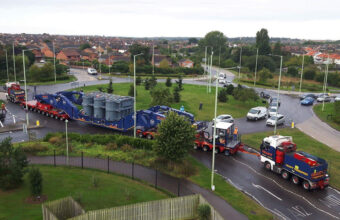
Leiston Transformer
Overview
We were tasked with finding the most cost-effective and workable solution to deliver a 132kv super grid power transformer, weighing 180 tonnes.
Following discharge from an ocean vessel, which originated in Korea, Hemisphere took responsibility for safely transporting the transformer from Rotterdam Port through to the National Grid site on the UK’s east coast. We’re extremely proud to have been involved in a project which is important to the environment and to our local community.
This on-shore transformer is a vital part of the Galloper wind farm project and, once operational, this wind farm will provide renewable energy for around 300,000 UK homes. As part of our scope of work, we appointed a trusted specialist trucking and installation company.
With our partner, we assessed the possible routing for the cargo both in terms of the UK port of discharge and the local trucking routes which would be allowed by the UK highways authorities and police.
Delivery
After several route surveys by our project managers and trucking company, it was decided that the only possible route would be to discharge the cargo at the Port of Lowestoft. Unfortunately, the Port of Lowestoft is heavily restricted for project cargo operations. This is due to local bridge restrictions to the north quay and shallow draft, as well as quayside heavy-lift restrictions to the south quay.
Our project managers therefore decided to charter a specialist sea-going barge with a shallow draft and hydraulic roll-on/roll-off ramps. This method was chosen so that once the transformer was loaded onto specifically engineered and positioned stands in Rotterdam, it would be possible to roll on to the barge using 10 x SPMT hydraulic axles to lift and roll the cargo off the barge at the discharge port.
Our thoughts
A Massive Undertaking
Due to the road weight, height and width restrictions, the transformer was built into a unique ‘Girder Bridge’ trailer supported by 20 modular axles and two push/pull tractor units. This adhered to special permits issued by the Highways Authority to allow the safe delivery of the transformer.
Once everything was in place, including additional contractors to remove any necessary street furniture, and specialist mobile tree surgeons to clear any overhanging trees, we were finally allowed to begin the delivery to the substation site. We carried out the move on a Saturday morning to avoid weekday commuter traffic.
As the final truck/trailer combination measured 70.5 x 5.3 x 4.8 metres, weighed around 430 tonnes in total, and was restricted by the authorities to travel at a maximum of 12.5mph, we moved in convoy with police escorts to close roads and avoid other vehicles. With additional stoppages en route for two railway crossing closures, the route of approximately 27 miles took almost seven hours to complete.
Results
On Sunday, our specialist installation contractor began to place precise jacking and skidding gear under the transformer to manoeuvre it into a specific final position required by the end user, a process which took a further 3 days to complete.
In addition to the main transformer unit, Hemisphere also had to undertake full customs clearance procedures in the Netherlands and handle an additional 42 cases of accessory parts in Rotterdam, which were to be installed around the main transformer. These cases of parts had to be delivered to the wind farm site in a specific order.
To comply with site requirements, we arranged to unload the cases from containers in Rotterdam and truck them to our 110,000ft2 warehouse in Ipswich, Suffolk where we stored the cases until called for delivery by the installation engineers – finally delivering to site using our fleet of curtain sided trailers. Throughout the entire planning, execution, port operations, delivery and installation, Hemisphere project managers followed the cargo every step of the journey to ensure a smooth and seamless delivery.






